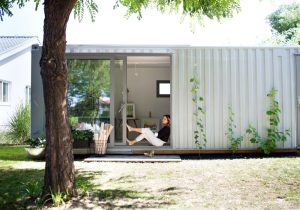Last Updated on February 27, 2024 by teamobn
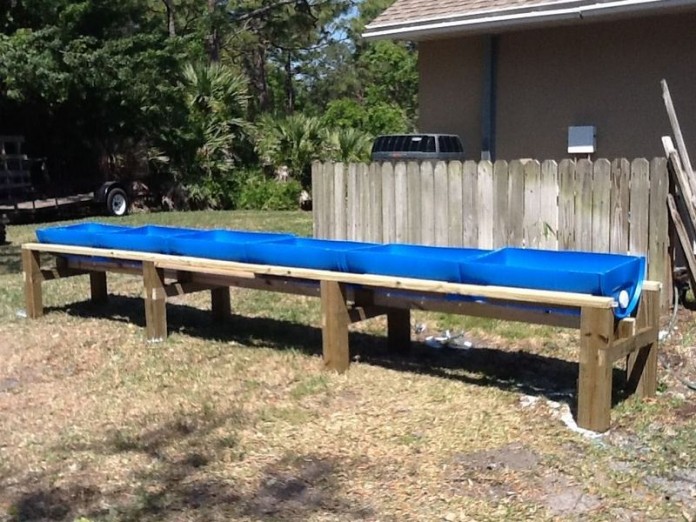
Raised planters aren’t a new idea. Dating back to 300 BC when the pre-Hispanic peoples of the Andes used them to prevent erosion, there is ample reason for their still-growing popularity today.
This easy and inexpensive raised planter stand is a great solution for a variety of garden issues.
A raised planter stand is a great option for keeping your garden organized, and if you don’t want to plant directly on the ground so as to keep critters away from your produce.
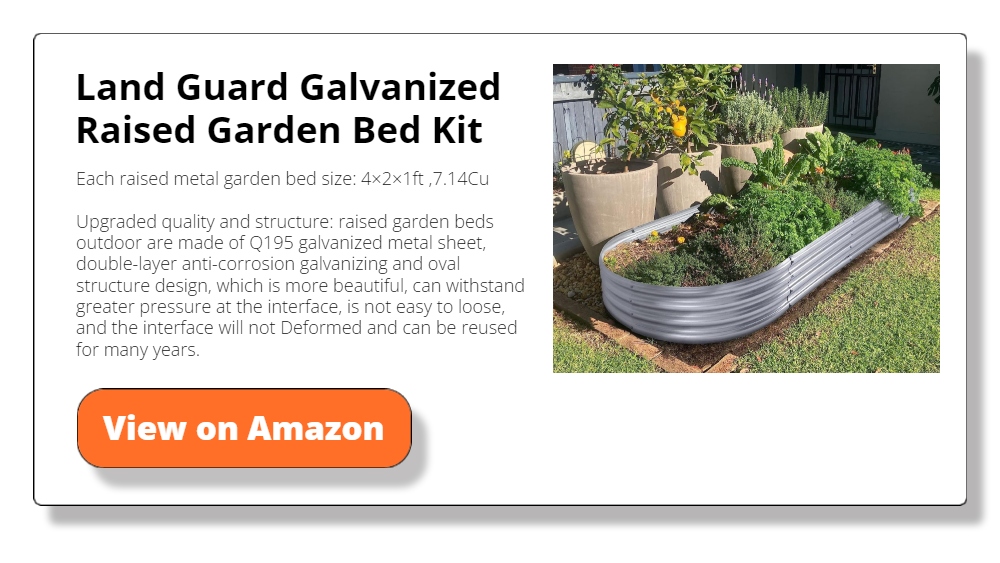
If you’re seeking a hassle-free approach to gardening, raised planter stands emerge as the ultimate solution. They not only simplify the process of incorporating fertilizers and soil amendments but also serve as champions in enhancing drainage while preventing soil compaction.
With these raised planter stands you’ll find that gardening becomes not only more convenient but also significantly more productive, providing a nurturing environment for your plants to thrive.
Plus raised planter stands can be used to create a custom growing environment for your plants, making it easier to control factors like temperature, humidity, and light.
This design also allows you to attach trellising!
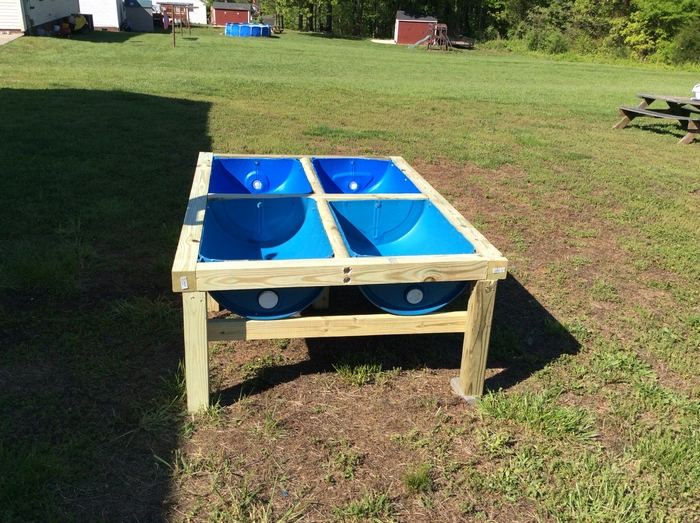
Constructing a raised planter stand presents an excellent opportunity to infuse your space with an extra touch of lush greenery, all without straining your budget. By repurposing timber from past woodworking endeavors, you can fashion a raised planter stand that is not only robust but also visually appealing.
Additionally, if you’re looking for an innovative way to introduce plant life, consider repurposing drums into unique and cost-effective planters. These drum planters are affordable and available right within your local area, making them a practical option for your gardening endeavors.
What would you be planting on your own raised planter stand?
If you have other ideas on how this can be improved, let us know in the comments section.
Click on any image to start the lightbox display. Use your Esc key to close the lightbox. ![]()

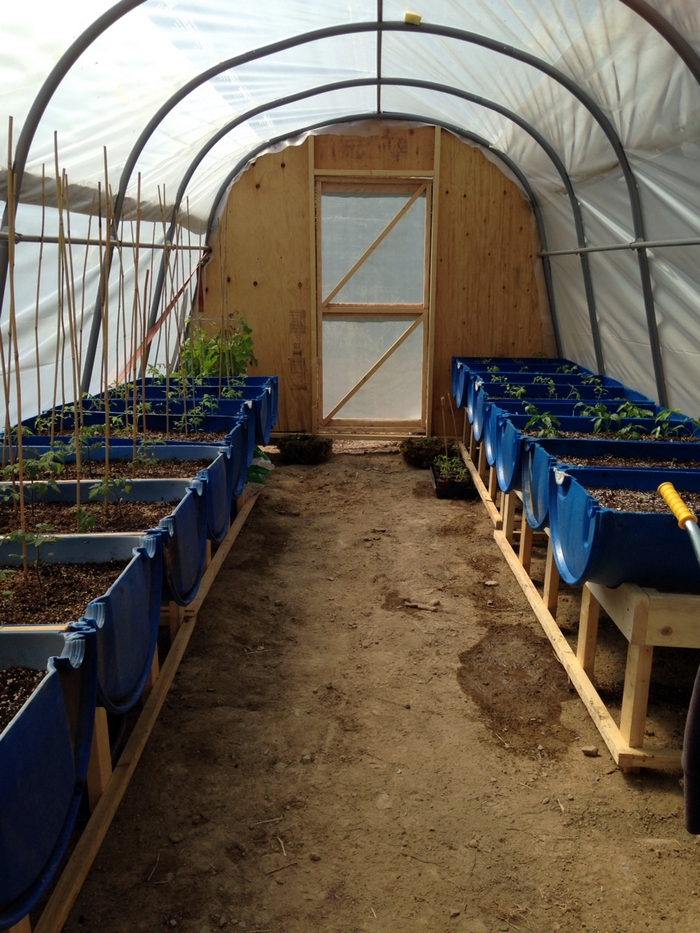
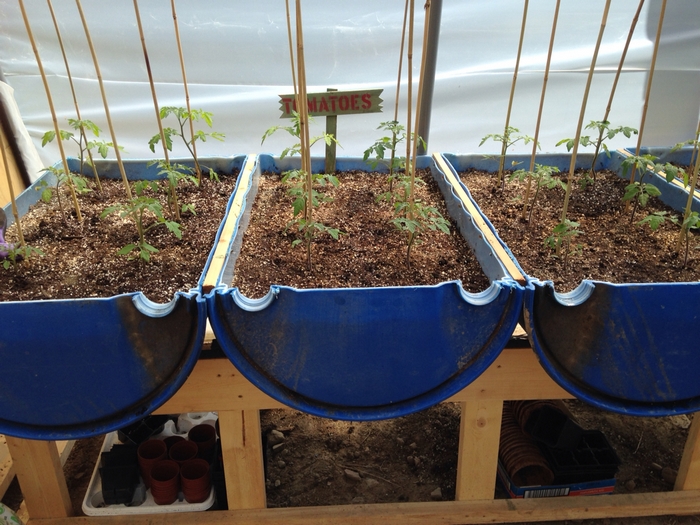
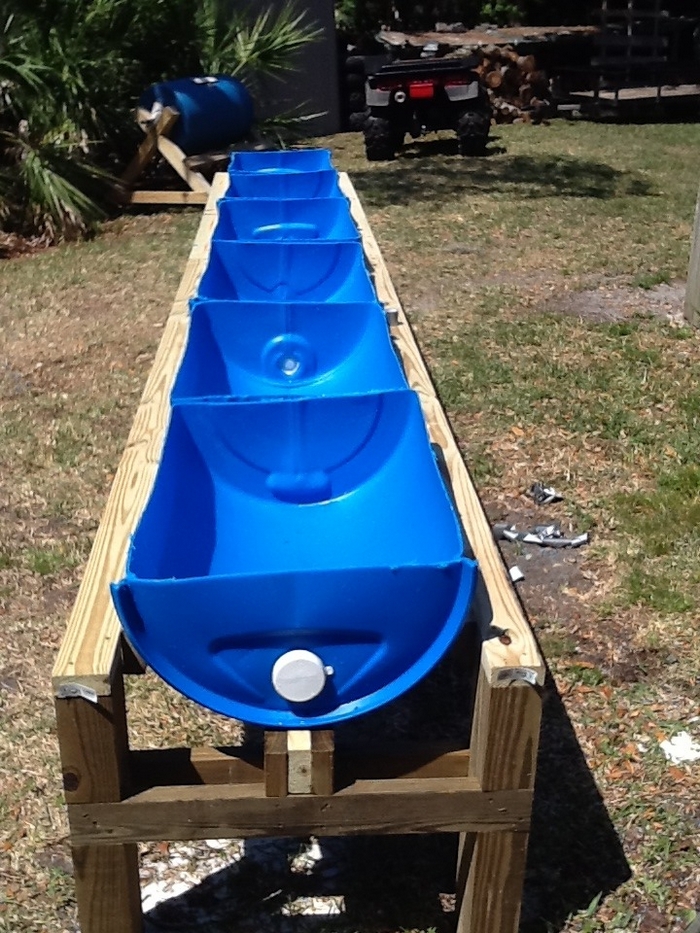
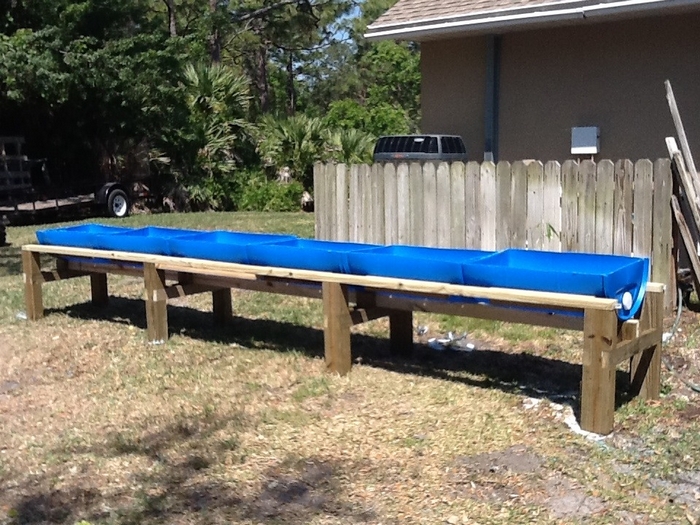
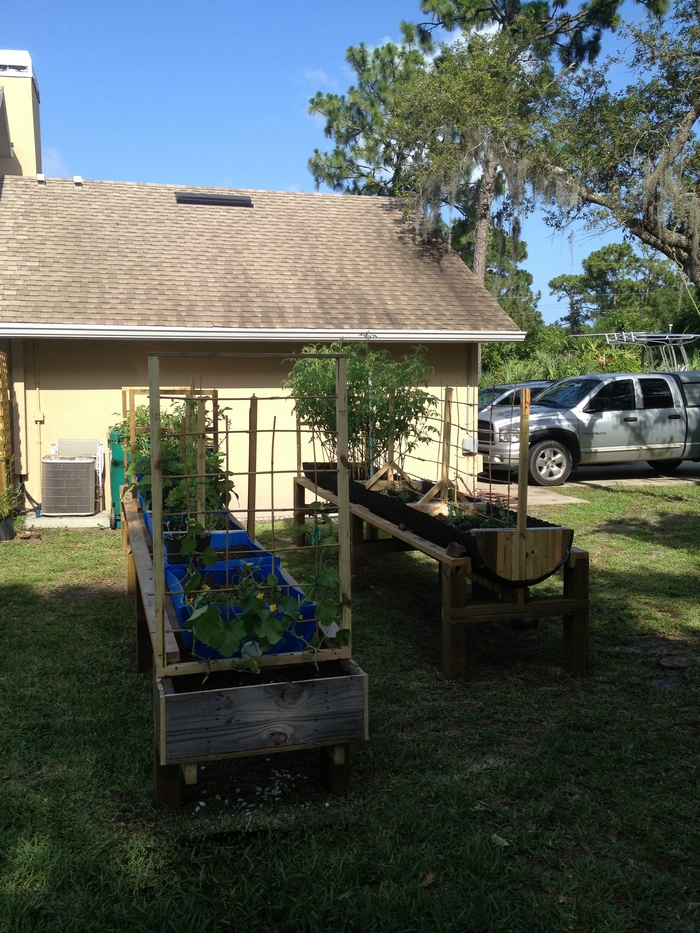
Contents [show]
Crafting a Raised Planter Stand!
Whether you’re an experienced gardener seeking to enlarge your cultivation area or a novice excited to nurture your own personal oasis, this undertaking is your pathway to flourishing achievements.
Are you ready to start this gardening adventure that not only elevates your plants but also enhances your gardening expertise? Begin by gathering all the essential materials and tools for the project!
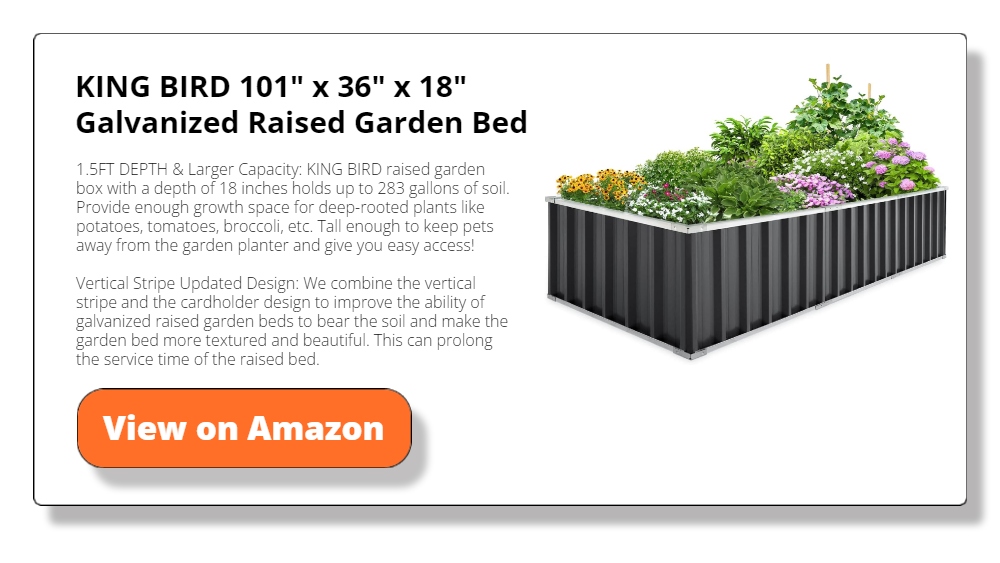
Materials
- (3) 55 Gallon Plastic Barrel
- 2×4 Pressure Treated Lumber
Tools
- Hand Saw
- Measuring Tape
- Clamps
- Straight Edge (square)
- Wood Glue
- Hammer
- Chisel
- Screws
- Power Drill/Driver
Steps
Here are the steps to make a raised garden planter:
1. Build The Assemblies
You’ll need four assemblies for three drums. Begin by building the four support assemblies that will connect the 2×4 stringers. For simplicity, make them identical and symmetrical.
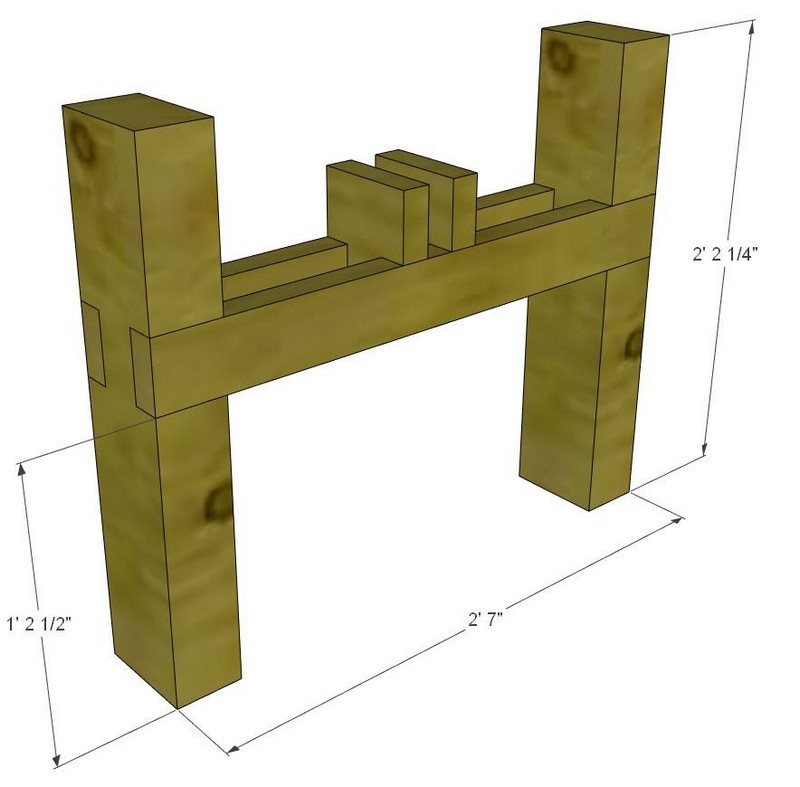
The legs are made from 4×6 pressure-treated (PT) lumber, with a height of 26-1/4″. The cross members connecting each leg are made from 2×4 PT and are joined together using dadoes cut.
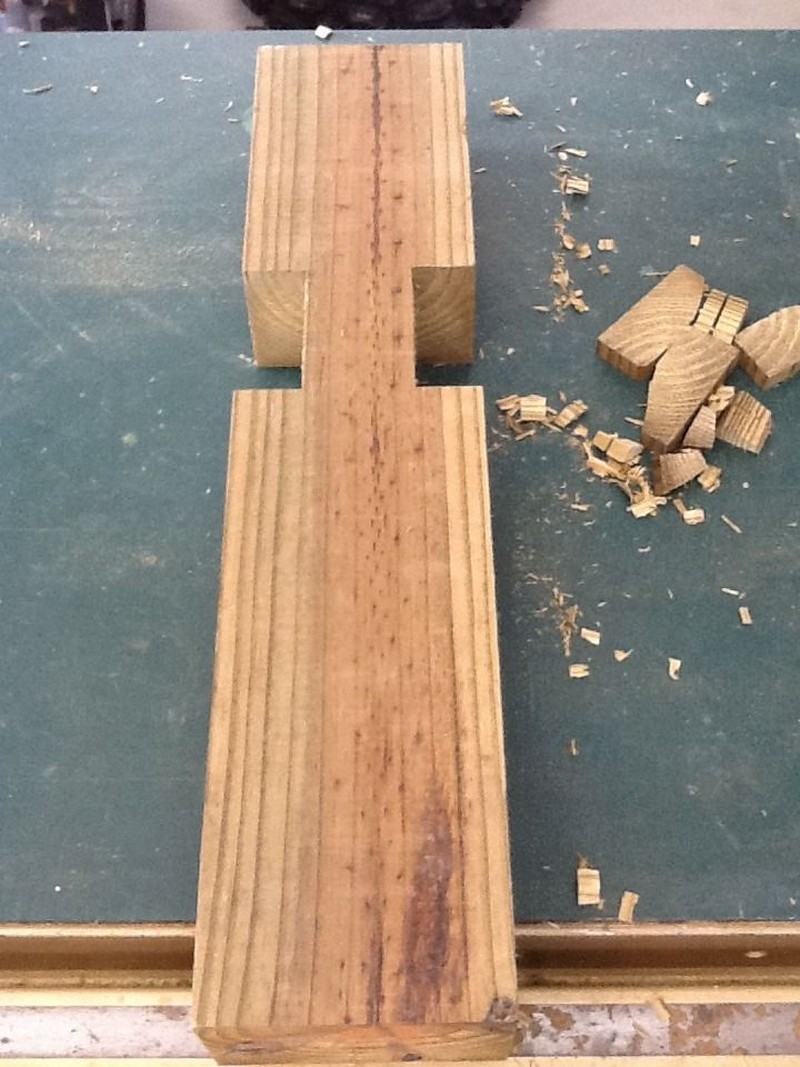
Cut cross members to 31″ then apply adhesive and attach screws in points connecting the members. Make sure the adhesive is evenly applied to both surfaces before attaching the screws. Use a level to make sure the cross members are even before attaching the screws.
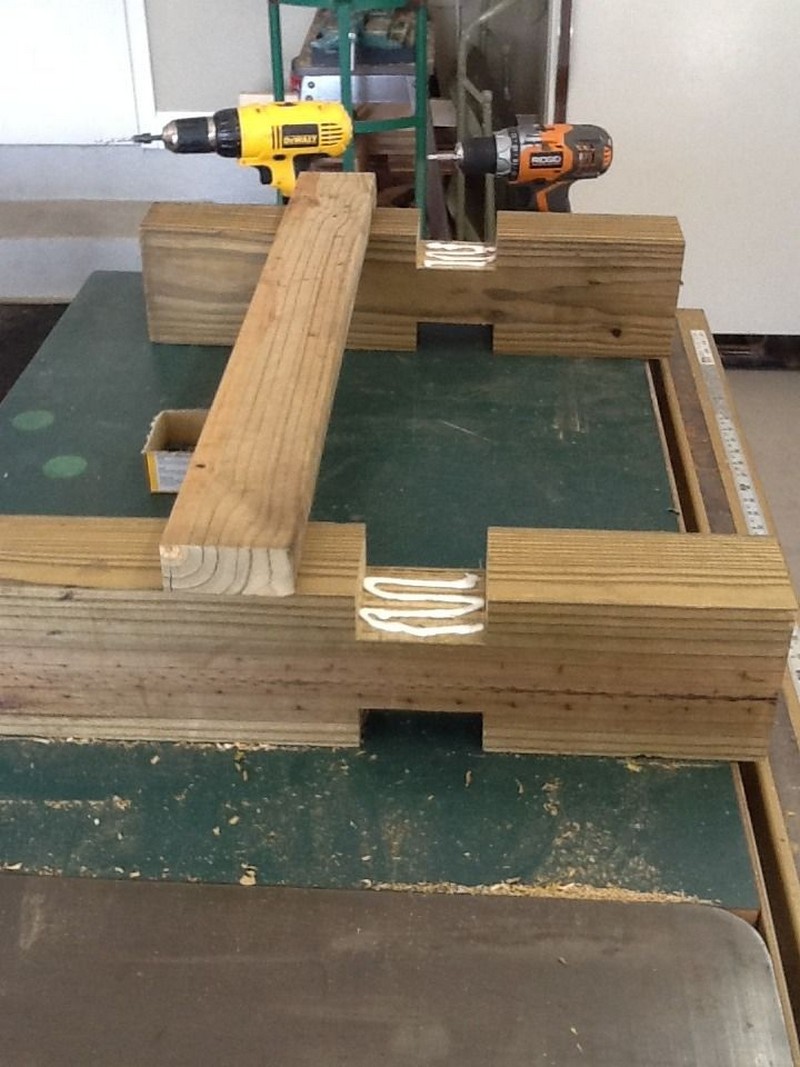
2. Connect The Assemblies
After building the assemblies, connect them together. Stake one of the four assemblies to the ground to prevent it from moving. Then measure the exact location where the next assembly should be attached. Stake the second assembly in the location determined earlier.
You can then lay a 2×4 on top of the legs and fasten them using a screw. After that side is done proceed to the other side. Attach a 2×4 on the assemblies’ cross member and screw it into place.

3. Attach Spacers
Using screws, attach 2x4s with a length of 2′ to the inner side of the 2x4s connecting the legs of assemblies. These will serve as spacers of your raised planter stand, giving the drums a snug fit and preventing them from rolling. This will ensure that your drums are stable and will not move around easily.
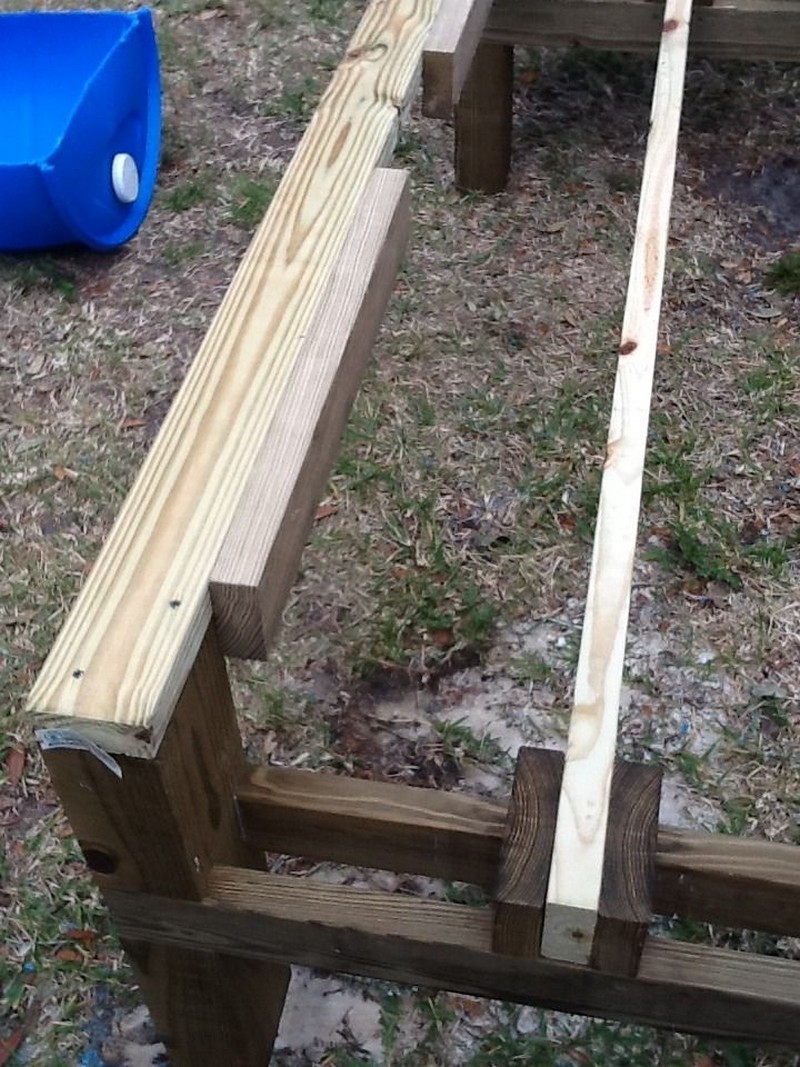
4. Cut And Install Drums
Delicately mark lines on the drums to indicate where the cuts will be made. Employ a circular saw equipped with a carbide-tipped blade to precisely cut the drums in half. After the drums have been halved, give them a thorough wash and let them air dry.
Drill holes for drainage. Lastly, install the drums and fill them with soil. You can use the 2x4s that connect the legs of the assemblies to add a trellis.
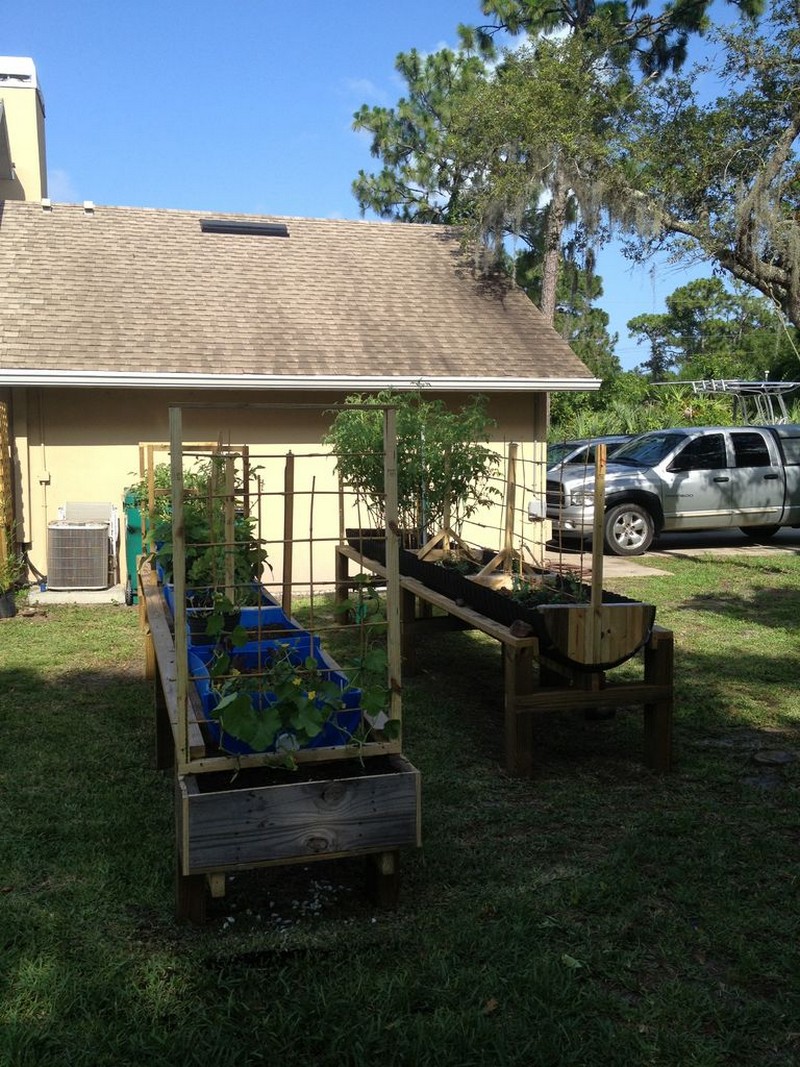

Thanks to RushFan for sharing this wonderful DIY idea!
Choosing the Right Materials for Your Raised Planter Stand
When embarking on the construction of a raised planter stand, selecting the appropriate materials is paramount. The choice of materials influences not only the durability and longevity of your planter but also its environmental impact and the health of the plants you aim to nurture. This guide explores various material options, weighing their benefits and drawbacks, to help you make an informed decision for your gardening project.
Wood
Wood remains a top choice for those creating raised planter stands, largely because of its natural beauty and ability to integrate effortlessly into a variety of garden styles. Among the wood options, cedar and redwood stand out for their intrinsic qualities that combat decay and deter pests.
The two wood materials ensure your raised planter stand remains robust and attractive over time. These types of wood, with their rich hues and textures, not only add a warm, organic touch to your garden but also provide a sturdy foundation for your plants to thrive.
However, the superior durability and aesthetic appeal of cedar and redwood come with a higher price tag, making them a premium choice for garden enthusiasts willing to invest in long-term performance.
For those seeking a more cost-effective alternative without compromising the health of their plants, pressure-treated lumber presents a viable option. It’s essential to select pressure-treated wood that is specifically labeled as safe for use in vegetable gardens or around edible plants. This precaution is crucial since older forms of pressure treatment used chemicals that could leach into the soil and potentially harm plant life.
Metal: Durable and Modern
Metal raised planter stands, crafted from materials like galvanized steel or aluminum, are celebrated for their exceptional strength and contemporary aesthetic. These metals offer unparalleled resistance to environmental elements, including moisture, pests, and extreme temperatures.
Metal’s natural resistance makes them a perfect choice for gardeners looking for longevity and minimal maintenance. The sleek lines and reflective surfaces of metal raised planter stands can significantly enhance the modern appeal of your garden space, providing a striking contrast to the natural greenery.
One notable consideration when opting for metal in raised planter stands is their thermal conductivity. Metal can absorb heat, potentially elevating the soil temperature more than desired during hot weather.
This characteristic requires strategic placement or the incorporation of insulating materials to mitigate any adverse effects on plant health. Despite this, the durability and low maintenance of metal raised planter stands make them a worthwhile investment for those seeking a blend of functionality and stylish design in their gardening projects.
Recycled Plastics and Composite Materials
In the world of gardening, the use of recycled plastics and composite materials for raised planter stands is gaining momentum, not only for their sustainability but also for their practical benefits. These innovative materials represent an eco-conscious choice, reducing waste by repurposing plastics that might otherwise end up in landfills.
Raised planter stands crafted from recycled plastics are celebrated for their longevity, offering resistance to rot, pests, and the vagaries of weather without the need for ongoing maintenance. This resilience makes them an ideal choice for gardeners looking for a hassle-free gardening solution.
Composite materials, blending wood fibers with plastic, present a unique proposition. They capture the natural beauty and texture of wood while inheriting the durability and resistance of plastic, making them a compelling choice for those wishing to combine aesthetic appeal with practicality in their raised planter stands.
While the upfront cost of composite materials can be higher compared to traditional wood or pure plastic options, their longevity and low maintenance requirements often justify the investment, making them a cost-effective solution in the long run for raised planter stands.
Concrete and Stone
For gardeners seeking a more permanent and robust solution, concrete and stone materials for raised planter stands are unparalleled. These materials lend a sense of permanence and solidity that is both visually appealing and functional.
The natural textures and colors of concrete and stone can complement the architectural elements of a garden, enhancing its overall aesthetic and blending seamlessly with the outdoor environment. Raised planter stands made from these materials are capable of supporting a significant weight of soil, making them suitable for a wide range of planting projects without the risk of deformation or collapse.
However, the choice of concrete and stone comes with considerations of immobility and initial costs. Once constructed, these raised planter stands are meant to remain in place, offering little flexibility for garden redesigns or relocations.
Additionally, the materials and labor required to construct these durable stands can be more expensive and labor-intensive than other options. Despite these factors, the timeless elegance, and unmatched durability of concrete and stone raised planter stands make them a worthwhile investment for those dedicated to creating a lasting and beautiful gardening space.
Considerations for Choosing Materials
- Durability: The choice of material for your raised planter stand must reflect an understanding of its ability to endure the specific conditions of your local climate. Materials that offer resistance to decay, moisture, and pests are crucial for ensuring the longevity of your raised planter stand.
- Safety: Safety is paramount, especially when your raised planter stand will host edible plants. It’s essential to choose materials that do not leach harmful chemicals into the soil. For wood options, ensure that if treated, the wood is certified as safe for use in vegetable gardens.
- Aesthetics: Aesthetics play a significant role in the selection of materials for your raised planter stand. The material should not only complement the design of your garden but also reflect your taste and the overall ambiance you wish to create.
- Environmental Impact: In today’s environmentally conscious world, considering the ecological footprint of your raised planter stand materials is more important than ever. Opt for materials that are sustainably sourced, such as certified wood or recycled materials, to minimize your garden’s impact on the planet.
- Cost-Effectiveness: Balance your budget with the quality and longevity of the material. Initial investment in durable and low-maintenance materials can lead to long-term savings.
- Maintenance Requirements: Some materials require more maintenance than others to retain their appearance and structural integrity. Consider how much time and effort you are willing to invest in the upkeep of your raised planter stand.
- Installation and Mobility: Evaluate the ease of installation and the potential need for mobility of your raised planter stand. Some materials may be more suitable for gardeners who anticipate needing to move or adjust their setups.
In conclusion, the material you choose for your raised planter stand should align with your gardening goals, budget, and design preferences. By considering the pros and cons of each material, you can create a raised planter stand that is not only functional but also a visually appealing addition to your garden space.
Seasonal Planting Guide for Raised Planter Stands
Elevating your gardening game with raised planter stands offers a unique opportunity to cultivate a diverse array of plants throughout the year. By understanding the seasonal cycles and selecting appropriate crops for each phase, gardeners can maximize their harvest and enjoy a continuous bounty.
This guide outlines key considerations and recommendations for planting in raised planter stands, ensuring your garden thrives in harmony with the natural rhythms of the year.
Spring
Spring is a time of renewal, making it ideal for planting a variety of vegetables, herbs, and flowers that thrive in cool, moist conditions. For raised planter stands, this is the perfect moment to sow seeds of leafy greens such as spinach, lettuce, and kale. Root vegetables like carrots and radishes also perform well, alongside early-blooming flowers to attract pollinators.
- Focus Crops: Lettuce, Spinach, Kale, Peas, Carrots, Radishes
- Planting Tips: Begin with frost-tolerant varieties and use mulch to retain moisture and warmth in the soil. Consider starting some seeds indoors to transplant as the weather stabilizes.
Summer
As temperatures rise, raised planter stands become the ideal home for warm-season crops that require more heat and sunlight. This period is perfect for tomatoes, peppers, cucumbers, and beans, which benefit from the improved drainage and warmer soil temperatures in raised planters. Additionally, summer flowers and herbs can be introduced to enhance the garden’s vibrancy and flavor.
- Focus Crops: Tomatoes, Peppers, Cucumbers, Zucchini, Basil, Marigolds
- Planting Tips: Ensure adequate watering and ventilation to manage the summer heat. Use taller structures within your raised planter stands for climbing plants like beans and cucumbers.
Fall
The cooler temperatures of fall create a second window for many spring crops, along with the introduction of hardier vegetables. It’s an excellent time to plant greens again, as well as root vegetables that can be harvested into the winter. Incorporating ornamental gourds or pumpkins can also add a festive element to your raised planter stands.
- Focus Crops: Kale, Swiss Chard, Beets, Carrots, Pumpkins, Ornamental Gourds
- Planting Tips: Start fall crops in late summer to ensure maturity before the first frost. Consider cover crops or mulching to protect the soil as temperatures drop.
Winter
In colder climates, winter might seem like a time to rest, but raised planter stands can still be productive. Cold frames or greenhouse covers can extend the growing season for certain crops. It’s also an ideal time to plan for the coming year, repair or improve your raised planter stands, and replenish the soil with compost or other organic matter.
- Focus Crops: Hardy Greens (under cover), Garlic (for spring harvest), Cover Crops
- Planting Tips: Use cold frames or burlap covers to protect against frost. Winter is also perfect for soil maintenance and planning your crop rotation for the next year.
By tailoring your gardening activities to the season, your raised planter stands can provide a sustainable and rewarding gardening experience all year round. Seasonal planting not only optimizes your garden’s productivity but also contributes to the health of your plants, ensuring they grow in conditions suited to their natural cycles.
Planting With Power!
Unlock the magic of gardening with a simple four-step guide. Craft a robust raised planter stand in no time! Not only will this stand to elevate your plants to new heights, but it will also enhance your entire gardening experience.
In just a handful of effortless steps, you’ll build a structure that not only supports your greenery but also adds a touch of elegance to your outdoor space. Say goodbye to bending and stooping, and hello to a tall and proud garden.
Raised planter stands also tend to warm up earlier in the spring and stay warmer in the fall, extending the growing season and letting you cultivate a wider variety of plants.
The height of raised planter stands can deter some ground-dwelling pests, providing a degree of natural pest control. And they add a structured and visually appealing element to your garden, enhancing its overall aesthetics.
If you have limited space, they let you maximize your gardening area by going vertical or utilizing small spaces more effectively. The soil in raised planter stands is less likely to become compacted, ensuring better aeration for plant roots.
This swift and user-friendly project serves as your golden ticket to fashioning a garden oasis that seamlessly marries style and functionality. With this sturdy raised planter stand, you’ll not only transform your outdoor space into an aesthetic wonder but also harness the practicality of an elevated gardening experience.
Are you ready to take on this raised garden planter project? Check out our raised herb garden guide next!


